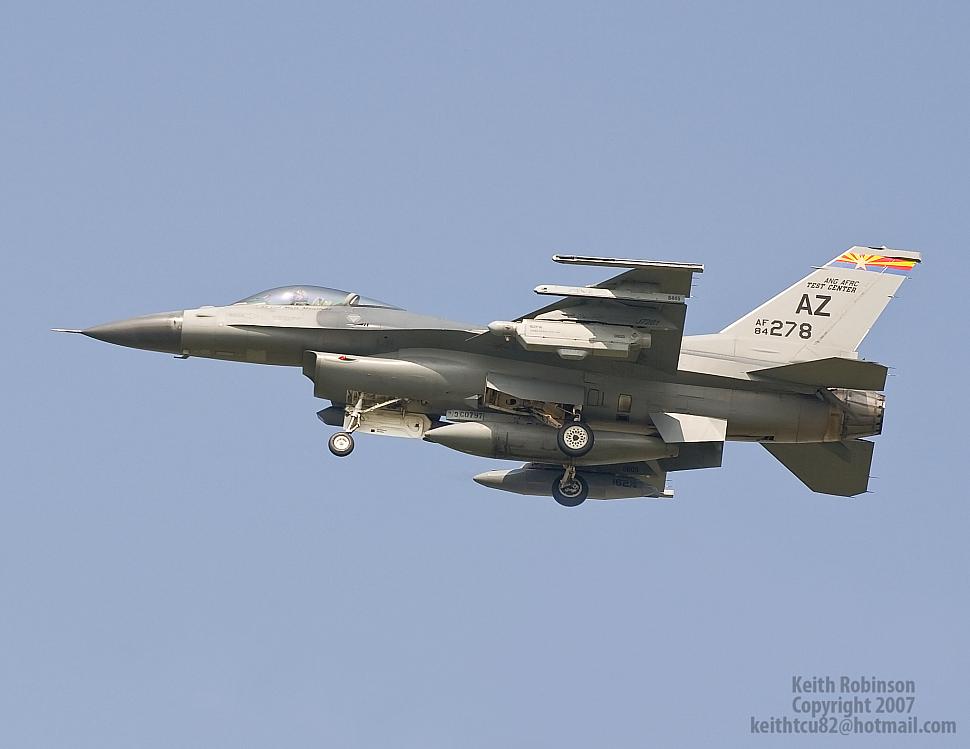Fighter Jet News
F-16 Fighting Falcon News
F-16 shoots down ballistic missile
December 5, 2007 (by
Asif Shamim) -
Raytheon successfully flight tested a key component of the Network Centric Airborne Defense Element (NCADE) missile defense system with the intercept of a test ballistic missile.
NCADE is a air-launched weapon system designed to engage short and medium-range ballistic missiles in the boost and ascent phase of flight. The test carried out on December 3rd, at White Sands Missile Range, N.M., demonstrated the NCADE infrared seeker's ability to acquire and track a ballistic missile target in the boost phase.
An F-16 from the Air Force Reserve Command Test Centre (AATC) launched two modified AIM-9X carrying the NCADE seeker at a test rocket. The first shot intercepted and destroyed the target and the second recorded the interception said Pentagon officials.
"This test provides clear evidence that the NCADE seeker is a viable solution against a boosting ballistic missile threat," said Mike Booen, Raytheon Missile Systems vice president of Advanced Missile Defence. "NCADE fills a critical niche in the Ballistic Missile Defence system and provides a revolutionary, low-cost approach to interceptor development and acquisition."
During an intercept the launch aircraft would have to get within 100 miles of the launch site to have any effective chance of catching the ballistic missile as it ascends. This would be have to be within the first few minutes of the launch. However the NCADE role maybe better suited against short to medium range missiles used in combat situations over the battle field.
The commonality with AMRAAM enables NCADE to be launched from a wide variety of aircraft. Its small size enables it to be also carried by and launched from smaller unmanned aerial vehicles, providing a potential operational advantage.
Last year, Raytheon team-mate Aerojet successfully tested the NCADE second stage axial propulsion system using an advanced higher performance and lower toxicity 'green' propellant designated as AF-M315. This was developed in conjunction with the US Air Force Research Laboratory at Edwards AFB.
Future testing will involve the missile's divert and attitude control system.
An F-16 from the Air Force Reserve Command Test Centre (AATC) launched two modified AIM-9X carrying the NCADE seeker at a test rocket. The first shot intercepted and destroyed the target and the second recorded the interception said Pentagon officials.
"This test provides clear evidence that the NCADE seeker is a viable solution against a boosting ballistic missile threat," said Mike Booen, Raytheon Missile Systems vice president of Advanced Missile Defence. "NCADE fills a critical niche in the Ballistic Missile Defence system and provides a revolutionary, low-cost approach to interceptor development and acquisition."
During an intercept the launch aircraft would have to get within 100 miles of the launch site to have any effective chance of catching the ballistic missile as it ascends. This would be have to be within the first few minutes of the launch. However the NCADE role maybe better suited against short to medium range missiles used in combat situations over the battle field.
The commonality with AMRAAM enables NCADE to be launched from a wide variety of aircraft. Its small size enables it to be also carried by and launched from smaller unmanned aerial vehicles, providing a potential operational advantage.
Last year, Raytheon team-mate Aerojet successfully tested the NCADE second stage axial propulsion system using an advanced higher performance and lower toxicity 'green' propellant designated as AF-M315. This was developed in conjunction with the US Air Force Research Laboratory at Edwards AFB.
Future testing will involve the missile's divert and attitude control system.
Related articles:
Forum discussion:
Tags
- Raytheon ADM-160B deployed from F-16 (2006-10-24)
- F-16 test team conducts first guided launch of AIM-9X (2004-07-19)
- AMRAAM: Details of New C-7 and D Variants. (2004-07-14)
- F-16's first AIM-9X Sidewinder launch (2004-04-19)
- Raytheon Awarded $217.8 Million for AMRAAM Production (1999-05-23)
- F-16 Fighting Falcon news archive
Forum discussion:
- Start a discussion about this article in the F-16.net forum.
Tags

